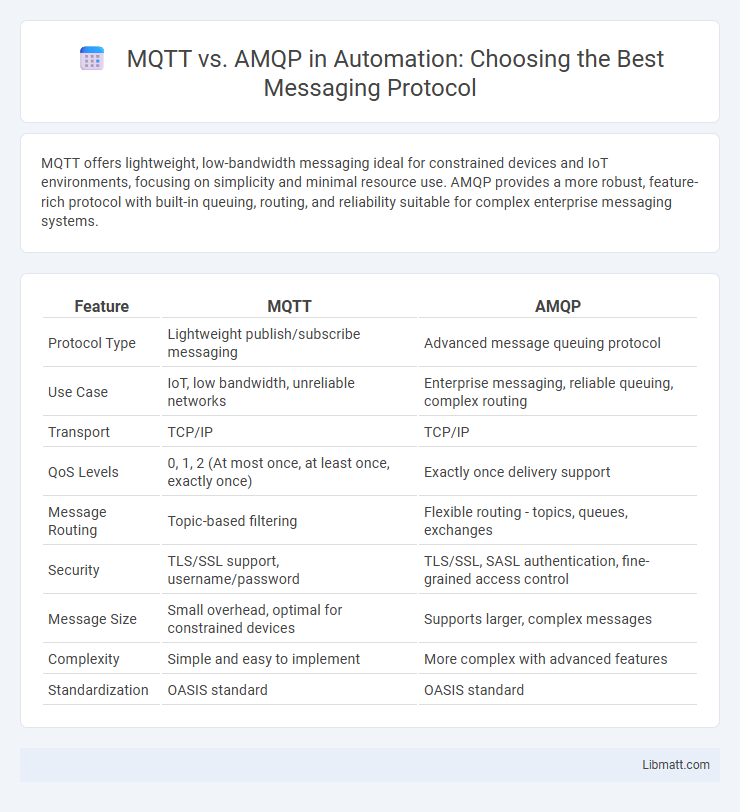MQTT offers lightweight, low-bandwidth messaging ideal for constrained devices and IoT environments, focusing on simplicity and minimal resource use. AMQP provides a more robust, feature-rich protocol with built-in queuing, routing, and reliability suitable for complex enterprise messaging systems.
Table of Comparison
| Feature | MQTT | AMQP |
|---|---|---|
| Protocol Type | Lightweight publish/subscribe messaging | Advanced message queuing protocol |
| Use Case | IoT, low bandwidth, unreliable networks | Enterprise messaging, reliable queuing, complex routing |
| Transport | TCP/IP | TCP/IP |
| QoS Levels | 0, 1, 2 (At most once, at least once, exactly once) | Exactly once delivery support |
| Message Routing | Topic-based filtering | Flexible routing - topics, queues, exchanges |
| Security | TLS/SSL support, username/password | TLS/SSL, SASL authentication, fine-grained access control |
| Message Size | Small overhead, optimal for constrained devices | Supports larger, complex messages |
| Complexity | Simple and easy to implement | More complex with advanced features |
| Standardization | OASIS standard | OASIS standard |
Overview of MQTT and AMQP
MQTT (Message Queuing Telemetry Transport) is a lightweight, publish-subscribe messaging protocol designed for low-bandwidth, high-latency, or unreliable networks, commonly used in IoT applications to enable efficient device communication. AMQP (Advanced Message Queuing Protocol) is a more feature-rich, broker-based messaging protocol aimed at enterprise systems requiring guaranteed message delivery, transaction support, and complex routing capabilities. Understanding the differences in protocol design and use cases helps you choose the right messaging system for scalable and reliable communication.
Key Features Comparison
MQTT is a lightweight messaging protocol optimized for low-bandwidth, high-latency networks, featuring a simple publish-subscribe model and Quality of Service (QoS) levels ensuring message delivery reliability. AMQP offers advanced message queuing, flexible routing, and transactional messaging, supporting robust security and interoperability in enterprise environments. While MQTT excels in IoT and constrained devices, AMQP is designed for complex, high-throughput business systems requiring guaranteed message handling and comprehensive protocol features.
Protocol Architecture Differences
MQTT employs a lightweight publish-subscribe architecture designed for minimal bandwidth and resource-constrained devices, using a single broker to manage message distribution. AMQP features a more complex, queue-based architecture with message orientation, routing, queuing, and reliable delivery through exchanges and bindings, suitable for enterprise-level applications. Your choice depends on whether you need simplicity and low overhead (MQTT) or robust messaging features and transactional guarantees (AMQP).
Use Cases and Applications
MQTT is ideal for lightweight, low-bandwidth scenarios such as IoT sensor networks, home automation, and mobile applications where minimal power consumption and reliable message delivery are essential. AMQP excels in complex enterprise messaging environments requiring guaranteed message delivery, flexible routing, and transactional support, such as financial services, logistics, and large-scale distributed systems. Evaluating Your specific use case involves considering network constraints, message patterns, and reliability requirements to select the protocol best suited for efficient communication.
Performance and Scalability
MQTT offers lightweight messaging with low latency and minimal bandwidth usage, making it ideal for performance-sensitive IoT applications with constrained devices and networks. AMQP provides robust message queuing and advanced routing capabilities, supporting higher scalability in complex enterprise environments with reliable delivery guarantees. Your choice depends on whether you prioritize fast, resource-efficient communication (MQTT) or scalable, feature-rich messaging infrastructure (AMQP).
Security Mechanisms
MQTT employs simple username/password authentication and supports TLS encryption to secure message transmission, making it suitable for lightweight IoT devices with basic security needs. AMQP offers advanced security mechanisms including SASL authentication frameworks, extensive encryption options, and granular access control, providing robust protection for enterprise messaging systems. Your choice between MQTT and AMQP depends on the required security level, with AMQP favoring comprehensive safeguards and MQTT catering to minimal resource environments.
Quality of Service Levels
MQTT offers three Quality of Service (QoS) levels--0 (at most once), 1 (at least once), and 2 (exactly once)--ensuring reliable message delivery tailored to network conditions and application needs. AMQP provides more granular QoS controls through message acknowledgments, transactional messaging, and flow control, supporting robust and guaranteed delivery in complex enterprise environments. Your choice between MQTT and AMQP QoS depends on the required reliability, network bandwidth, and application criticality.
Implementation and Integration
MQTT offers lightweight implementation ideal for resource-constrained devices, enabling seamless integration with IoT ecosystems through simple publish/subscribe messaging. AMQP provides a robust, message-oriented middleware solution with advanced queuing, routing, and transaction management, better suited for enterprise-level applications requiring reliable, secure messaging. Your choice between MQTT and AMQP depends on device capabilities and the complexity of your integration needs.
Pros and Cons of MQTT and AMQP
MQTT offers lightweight messaging with low bandwidth usage and is ideal for IoT devices requiring minimal resource consumption, but it lacks built-in message queuing and complex routing features. AMQP provides robust message queuing, reliable delivery, and advanced routing capabilities, making it suitable for enterprise-level applications, yet it demands higher bandwidth and processing power. The choice between MQTT and AMQP depends on system complexity, resource availability, and communication requirements.
Choosing the Right Protocol
When choosing the right protocol for IoT or messaging applications, consider MQTT for lightweight, low-bandwidth environments requiring minimal power consumption and simple publish-subscribe communication. AMQP suits complex enterprise systems needing guaranteed message delivery, transactional capabilities, and robust routing options. Your decision hinges on balancing resource constraints with the need for reliability and protocol features.
MQTT vs AMQP Infographic

 libmatt.com
libmatt.com